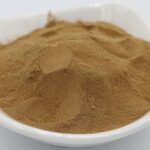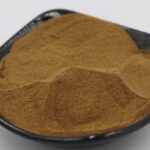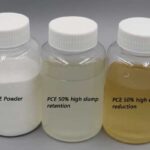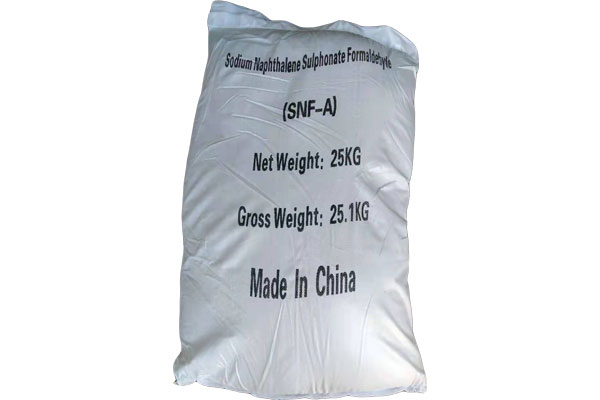Home » What Is Concrete Water Reducer

Concrete water reducer is the most widely used and most effective mixing material among the concrete admixtures. Its main function is to improve the rheological properties of the concrete mixture. Adding a water-reducing agent to concrete can reduce water consumption, lower water-cement ratio, improve the hardening performance of concrete, increase concrete strength, increase concrete rheology, and save cement consumption. Without changing the ration of various raw materials other than cement and the strength of concrete, adding a certain proportion of concrete water reducing agent can save more than 15%-30% of the amount of cement.
Water Reducing Admixture for Concrete We Can Supply
Would like The Quotation?
Leave your demands in detail here, we will reply you quickly.
What Are Classifications of Concrete Water Reducer
According to the water reducing and enhancing ability of concrete water reducer, it is divided into the following types. Ordinary water reducing agent, also known as plasticizer. Its water reducing rate is not less than 8%, represented by lignosulfonates. Superplasticizer, the water reducing rate isn’t less than 14%, including naphthalene series, melamine series, sulfamate series, aliphatic series, etc. High-performance water-reducing agent, the water-reducing rate is not less than 25%, represented by polycarboxylic acid-based water reducer. It can also be divided into early strength type, standard type and retarded type.
According to the chemicals composition, it is usually divided into lignosulfonate superplasticizer, naphthalene superplasticizer, melamine superplasticizer, sulfamate superplasticizer, fatty acid superplasticizer and polycarboxylate superplasticizer.
Lignin-based Water Reducer
Including calcium lignosulfonate, sodium lignosulfonate, magnesium lignosulfonate. Among them, calcium lignosulfonate is the most widely used. Lignin-based superplasticizer has retarding effect on concrete. If the dosage is too large or at low temperature, its retarding effect is more significant. And it may also reduce the strength of concrete. This type of concrete water reducer can be used in general concrete engineering, especially for large area pouring, slip form construction, pumping concrete and summer construction. They should not be used alone in winter construction, need to be used in combination with early strength agent or antifreeze agent. They are also not suitable to be used for steam curing concrete and prestressed concrete alone, so as to avoid looseness on the surface of the concrete after steam curing.
Naphthalene-based superplasticizer
Naphthalene-based superplasticizer is an aromatic sulfonate formaldehyde condensate. The main components of this type of water reducer are naphthalene or the condensate of naphthalene homologue sulfonate and formaldehyde, which belong to anionic surfactants.
The structural characteristics of naphthalene base water reducer are that the hydrophobic main chain is a bicyclic or polycyclic aromatic hydrocarbon connected by methylene, and the hydrophilic functional group is -SO3M connected to the aromatic ring. An important indicator of polynaphthalene sulfonate is the content of NaSO4.
The water reducing rate of naphthalene-base water reducer at the recommended dosage is generally between 15% and 25%, which basically doesn’t affect the setting time of concrete. It has low air entrainment, and the effect of improving concrete strength is obvious.
Melamine Based Superplasticizer
Melamine based water reducer is a water-soluble polymer. Its main component it sulfonated melamine formaldehyde condensate, which belongs to anionic, early strength, non-air-entraining superplasticizer. Its water reduction rate can reach 25%.
Melamine-based superplasticizer is of low air-entraining type and have no retarding effect. The water reducing rate is equivalent to that of SNF water reducer admixture. It has better reinforcement effect on concrete, but the slump loss of concrete is also faster after adding traditional melamine concrete water reducer. Due to its colorless and low air-entraining characteristics, it is suitable for the production of dry mortar, colored pavement bricks and fair-faced concrete.
Sulfamate series superplasticizer
Sulfamate superplasticizers, also known as monocyclic aromatic hydrocarbon superplasticizers, are mainly composed of alternating phenyl and methylene groups in the hydrophobic backbone of the polymer. This type of water reducing agent has a comb-shaped structure.
The general dosage of the superplasticizer is 0.2%-0.5%, which has the characteristics of high water reduction rate and small concrete slump loss. When the content of sulfamate water reducer is high, it is easy to cause excessive bleeding and retardation. Therefore, under normal circumstances, compounding sulfamate concrete water reducer admixture with naphthalene water reducing agent can not only improve the adaptability of naphthalene sulfonate to cement, but also enhance the slump retention of concrete.
Aliphatic series superplasticizer
Aliphatic superplasticizers mainly refer to aliphatic hydroxysulfonate condensates synthesized by using acetone, sulfite, formaldehyde, etc. Aliphatic concrete water reducer have abundant and cheap raw materials, as well as simple process. The synthesis cost is relatively low, and its water reducing rate is high. It won’t cause the concrete to secrete water too much and has little effect on the setting time of concrete. The water reducer admixture has a large water reducing rate and can promote the early and late strength of concrete. No crystallization in winter, no air entrainment, no chlorine salt, no corrosion to steel bars, and its adaptability to cement varieties is better than naphthalene based concrete water reducer. It is suitable for the production of prefabricated components.
Polycarboxylate Water Reducer
As a high-efficiency water-reducing agent, the water reducing property of polycarboxylate superplasticizer is generally 25%. It has a wide compatibility with the matrix material, but a narrower compatibility with the sand and gravel material. In the process of use, the loss of slump and expansion is small or there is no loss. The fluidity is large. It has good water retention, cohesiveness and climate adaptability, but it has higher technical requirements.
What is the water reduction rate of common water reducers?
| Types | Water reduction rate | Mixing amount | Slump retention | Applications |
| lignosulfonate | 8%~15% | 0.2%~0.5% | Bad | Low-strength concrete |
| naphthalene water reducer | 15%~25% | 0.5%~1.5% | Medium | Conventional engineering |
| Melamine-based | 18%~25% | 0.5%~1.5% | Bad | Early-strength, refractory concrete |
| Polycarboxylate superplasticizer | 25%~40% | 0.1%~0.3% | Excellent | High performance concrete |
| sulfamate | 20%~30% | 0.3%~0.8% | Good | High fluidity concrete |
| Aliphatic water reducing agent | 15%~20% | 0.5%~1.2% | Medium | Common prefabricated components |
Selection suggestions for Concrete Water Reducer
Economical efficiency is preferred. Low-grade concrete can choose lignin or aliphatic systems.
High strength requirements. Polycarboxylate superplasticizer is the only choice for concrete above C60.
High temperature environment. Polycarboxylate superplasticizer and collapse-preserving components.
Low temperature environment. Melamine system or early-strength polycarboxylic acid.
Environmental protection requirements. Polycarboxylate superplasticizer is formaldehyde-free and chlorine-free, and meets the standards of green building materials.
What Are Function and Mechanism of Water Reducing Agent
Concrete water reducer can reduce the water consumption without affecting the normal construction of cement concrete. During the hardening process of cement concrete, less water will be dissipated, so the internal pores of concrete are less, which can improve the strength of concrete.
Water reducer admixture can greatly improve the construction workability of cement concrete and reduce the energy consumption during construction and mixing.
Water reducing agent can reduce the amount of cement and water without reducing the performance and mechanical indicators of concrete, thereby reducing the cost of construction.
The two ends of the molecular structure of water reducer admixture are the hydrophilic end and the hydrophobic end points the gas or solid interface. In the process of use, the hydrophilic end points to water, while the hydrophobic end points to the gas or solid interface. So the interface between water and the gas and solid phases can be reduced, so as to achieve the effect of dispersion. In the normal concrete construction and mixing process, once water is added to the cement, the cement will immediately form a flocculent structure. If a water-reducing agent is added, on the one hand, it will adhere to the surface of the cement particles and block the contact interface between the cement particles and water. On the other hand, the hydrophilic end of the concrete water reducer adsorbs a certain amount of water molecules, which can lubricate the cement particles and make them easier to disperse. The hydrophilic base is negatively charged. After being adsorbed on the surface of the cement particles, the cement particles also have the same negative charge, which repel each other to make the cement particles more dispersed, reduce the amount of water, and improve the fluidity of the cement concrete.
Dispersion. After the cement is mixed with water, due to the hydration of the cement particles, and electric double layer structure is formed on the surface of the cement particles to form a solvated water film. In addition, the surface of the cement particles has an opposite charge to cause the association between the cement particles and the cement slurry to form a flocculating structure, so that 10%-30% of the mixing water is wrapped in the cement particles and can’t participate in free flow and lubrication. This will affect the fluidity of the concrete mixture. When the water reducing agent is added, the molecules of concrete water reducers can be directionally adsorbed on the surface of the cement particles, so that the surface of the cement particles is charged with the same kind of electric charge, forming an electrostatic repulsion effect. This can promote the mutual dispersion of cement particles, the disintegration of the flocculation structure, release part of the water that is wrapped and participate in the flow, thereby effectively increasing the fluidity of the concrete mixture.
Lubrication. The hydrophilic group in the concrete water reducer is very polar, so the water-reducing agent adsorption film on the surface of cement particles can form a stable solvated water film with water molecules. This water film has a good lubricating effect and can effectively reduce the sliding resistance between cement particles, thereby further improving the fluidity of the concrete.
Steric hindrance. The hydrophilic branch in the water reducer structure stretches in the aqueous solution, thereby forming a hydrophilic three-dimensional adsorption layer with a certain thickness on the surface of the adsorbed cement particles. When the cement particles approach, the adsorption layer begins to overlap, that is, steric hindrance is generated between the cement particles. The more overlap, the greater the steric hindrance and the greater the hindrance to the cohesion between cement particles, so that the slump of the concrete is maintained well.
The slow-release effect of graft copolymer branch chain. In the preparation process of new water-reducing agents such as polycarboxylic acid concrete water reducing agent, some branched chains are grafted on the molecules of the water-reducing agent. The branched chains can not only provide steric hindrance, but also can be slowly cut off in the high alkalinity environment of cement hydration, thereby releasing substances with dispersing effect, which can improve the dispersion of cement particles and control the slump loss.
FAQ
Q1: Can water reducers and retarders be used together?
A: Yes. In projects with high temperatures or where the setting time needs to be extended, compound retarders (such as sodium gluconate) can effectively reduce slump loss and improve construction performance. However, the optimal ratio must be determined through experiments to avoid excessive retardation.
Q2: What are the consequences of excessive use of water reducers?
A: It may cause concrete segregation, bleeding, and even strength loss. Excessive use of PCE may also introduce too many bubbles, affecting durability. It is recommended to use it strictly according to the recommended dosage and verify it through trial mixing.
Q3: What is the effect of water reducer on concrete strength?
A: Proper use of water reducers can reduce the water-cement ratio and significantly improve strength. For every 10kg reduction in water, the strength will increase by 3-5MPa in 28 days. However, excessive or inferior water reducers may lead to insufficient strength growth in the later stage.
Q4: How to judge the compatibility of water reducers and cement?
A: Through the net paste fluidity test or concrete trial mix:
If the fluidity increases steadily with the increase in the dosage, it means that the compatibility is good.
If a “saturation point” appears, that is, continuing to increase the dosage has no effect, the compatibility is poor.
Q5: Will water reducers corrode steel bars?
A: Qualified water reducers do not contain chloride ions and will not corrode steel bars. But it should be noted that improperly compounded early strength agents may contain chloride salts. Marine engineering concrete should choose anti-corrosion water reducers.
Q6: Why does the effect of water reducers deteriorate at high temperatures?
A: High temperature accelerates cement hydration, resulting in:
Water reducer molecules are consumed rapidly.
Water evaporation is accelerated and slump loss is aggravated.
Q7: Can water reducers be used for gypsum-based materials?
A: Ordinary water reducers have poor effects on gypsum, so special water reducers, such as modified melamine series, need to be selected. Some models of PCE water reducers can be used, but they need to be tested and verified.
Q8: What is the shelf life of water reducers?
A:
Liquid water reducers: 6-12 months (need to be protected from light and frost).
Powder water reducers: 12-24 months (need to be moisture-proof).
The water reduction rate of expired water reducers may drop by more than 30%.
Q9: Can water reducers reduce the amount of cement used?
A: Yes. By reducing the water-cement ratio, the amount of cement can be reduced by 8-15% while maintaining the same strength.
Q10: Why do some water reducers cause concrete bleeding?
A: Too high a water reducer dosage, poor aggregate grading, poor compatibility between water reducers and cement, etc.
Q11: What is the effect of water reducers on concrete shrinkage?
A: High-quality water-reducing agent can reduce drying shrinkage by reducing the water-cement ratio. But please note:
Air-entraining water-reducing agent may increase shrinkage.
Early-strengthening water-reducing agent may aggravate early plastic shrinkage.
Q12: How to solve the problem of concrete bubbles caused by water-reducing agent?
A: Add defoaming agent, adjust the mixing time, and choose low-air-entraining water-reducing agent.
Q13: What is the relationship between water reduction rate and solid content?
A: There is no direct relationship. Solid content only indicates the concentration of active ingredients, while water reduction rate depends on molecular structure and adsorption characteristics.






